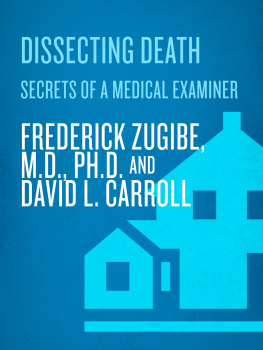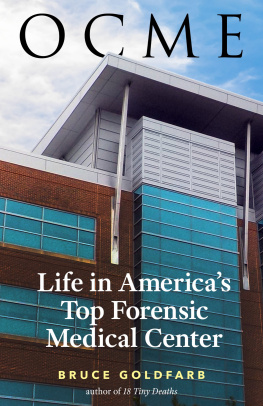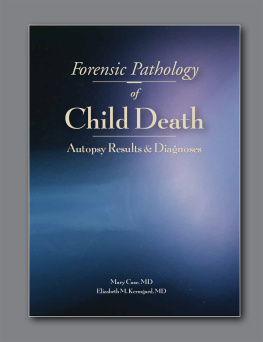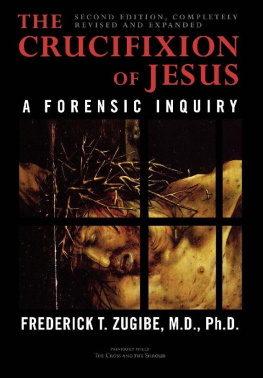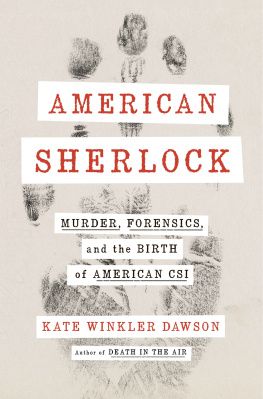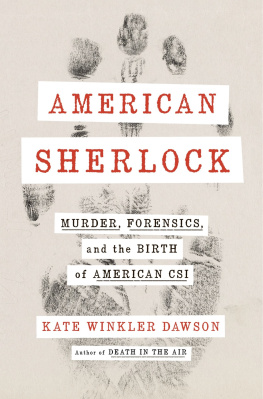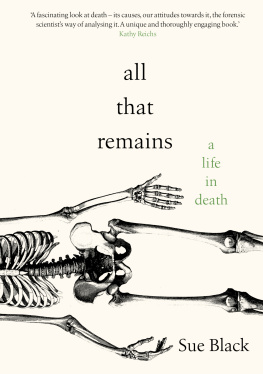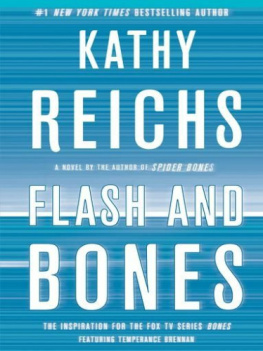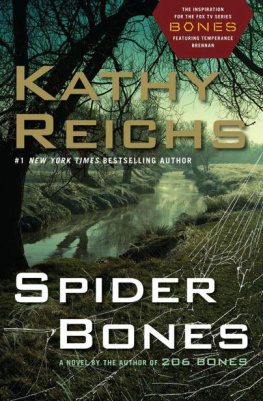Contents
Landmarks

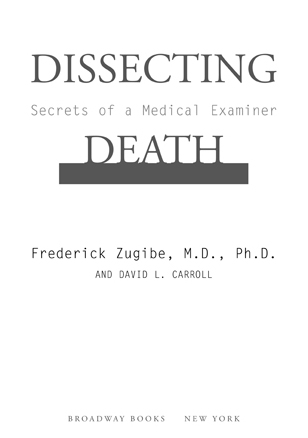
CONTENTS
CHAPTER 1
Of Ice Men and the Lure of Forensics
CHAPTER 2
Scenes of the Crime:
Two Lovely Missing Susans
CHAPTER 3
The Corpse in the Leather Mask
CHAPTER 4
The Slashed-Face Murder
CHAPTER 5
Conviction Is in the Details:
The Brinks Robbery
CHAPTER 6
Money, Cigarettes, and Telltale Shoes:
Solving the Gas Station Killing
CHAPTER 7
Joan
CHAPTER 8
One... Two?... Three!
The Child Minder Autopsies
CHAPTER 9
The .38-Caliber Yarmulke
CHAPTER 10
Finding Out Who:
The Case of the Missing Reporter
CHAPTER 11
Bungled Cases, Ingenious Methodologies, Forensic Curiosities
This book is dedicated to my wife, Catherine,
and to our seven children, Fred, Jr., Tom, Cathy,
Theresa, Mary, Matthew, and Kevin, and to their
families, all of whom have been the cornerstone
for all my endeavors and who always provided each other
with love, respect, and caring.
ACKNOWLEDGMENTS
I wish to acknowledge the early staff of the medical examiner's office: assistant medical examiners Dr. Leo Weishaar and Dr. John C. Petrone; medical investigator James Costello; toxicologist Walter Matusiak; autopsy assistant Tom Zugibe; and forensic secretary Bernadette Abbatecola, all of whose dedication and determination helped me to overcome the many obstacles and overwhelming odds in laying the groundwork that ultimately led to an ultramodern medical examiner system that attained national recognition. I also wish to acknowledge the efforts and loyalty of the entire staff of the medical examiner's office, who always worked together as a team, over the subsequent years: Jimmie Costello, my senior medical investigator, who served with me for over thirty-three years; my medical investigators Mark Breithaupt, Joseph Segelbacher, and Richard Hamilton; assistant medical examiners Dr. Burton Allyn, Dr. Arthur Goldstein, Dr. Richard King, and Dr. John Recht; pathologists Dr. Jim Redner, Dr. Michel Janis, Dr. Eduardo Zappi, Dr. Mark Zappi, and Dr. Hiroshi Nakasawa; forensic odontologists Dr. Arthur Goldman and Dr. Michael Varieur; toxicologists Dr. Jesse Bidanset, Dr. Joe Balkan, Bob Dettling, and Charles Salerno; forensic technician Melinda Szotyory; and forensic secretaries Minerva Olivo, Victoria Affrunti, and Rosemary Russo. My successes would not be complete without mentioning the sterling cooperation received from the investigators and ADAs of the district attorney's office, the county sheriff's department, including the BCI unit investigators and deputy sheriffs, and the detectives and patrolmen from all of the police departments of Rockland County. I also wish to acknowledge the dedication and writing skills of David Carroll, my coauthor, and Stacy Creamer and the staff at Doubleday for their sterling cooperation.
Frederick Zugibe, M.D., Ph.D.
With warm thanks to Stacy Creamer of Broadway Books for her help in overseeing the manuscript, providing insightful advice, and most of all for believing in this project.
With thanks to Tom Zugibe for his time and information.
David L. Carroll
CHAPTER
1
_________
Of Ice Men and the Lure of Forensics
The great and constant need of those who investigate homicide and practice forensic pathology or criminal law is a warm humanism.
RAMSEY CLARK, FORMER U.S. ATTORNEY GENERAL
Seeking truth to protect life.
MOTTO OF THE ROCKLAND COUNTY MEDICAL EXAMINER'S OFFICE
CORPSE BY THE WALL
NYACK, NEW YORK, IS A HISTORIC HUDSON RIVER VALLEY TOWN FAMOUS for its antique stores and sensible restaurants. People frequently make the twenty-mile drive up from New York City to spend a lazy afternoon drifting in and out of the town's quaint shops, or walking Nyack's network of shore trails that fronts the mighty Palisades. The house of the painter Edward Hopper is now a museum and a major tourist attraction. The cottage where the writer Carson McCullers died is frequently visited.
Small Town, USA, but with a lot of polish. Not a neighborhood for gruesome frolics.
Yet on a warm September day in 1983, along the heavily forested Clausland Mountain Road a quarter mile out of town, Patrolman Edwin Gonzalez, a Palisades Park police officer on morning patrol, spies a woman's blouse crumpled up near an old stone wall along the south side of the road.
Patrolman Gonzalez gets out of his car to investigate.
As he walks toward the blouse he notices an even more suspicious-looking object, a stuffed, heavy-duty garbage bag, the type contractors use to dispose of construction materials. The bag was apparently dumped over the wall, then rolled down a slight incline before stopping between two rocks. It is wrapped with a great deal of tape and rope. It gives off a rank odor and displays bulges where arms and feet and heads might be.
The officer surveys the bag for several minutes, senses trouble, but knows how risky it can be, forensically speaking, to touch a suspicious piece of evidence. Since he is in the Orangetown district of Rockland County, he calls Lieutenant Youngman from the Orangetown Police to come over and investigate.
Lieutenant Youngman is quickly on the scene.
And he agrees, unwrapping the bag would be unsound procedure at this point. Nor is it necessary: circling the bundle, he notices a human foot jutting out from a hole in the bottom of the wrapping.
Lieutenant Youngman calls the Rockland County Medical Examiner's Office. Since I am the chief medical examiner for the County of Rockland, it is my duty to examine the body on site, then transport it to the morgue for autopsy. I drive directly to the scene of the crime.
The first sight that greets me as I approach the foul-smelling sack is a spotted garden snake slithering out from a hole in the bottom. Flies buzz around it crazily, and an army of carrion beetles marches in and out of small holes in the plastic, some carrying tiny packets of decomposed flesh.
Now as most people know from media hullabaloos such as the O. J. Simpson trial, when police and medical examiners arrive at a crime scene the first few minutes spent examining a corpse and collecting evidence can make or break a case. Certainly, this scene is no exception. This body must be handled gingerly, or important evidence will be contaminated.
Slowly, slowly is the watchword.
STRANGE WRAPPINGS
Slowly, it turns out, is an understatement.
First, the County Sheriff's Bureau of Criminal Investigation (BCI) arrives and sets to work taking pictures of the bag and of the wooded area surrounding it. As they position themselves here and there, snapping the crime scene from various angles, I stand nearby and study the bag. There is, every official at the site agrees, something puzzling about the way it is packaged.
For starters, when a murdered body is dropped off, it is usually loosely trussed, unceremoniously stuffed into a cardboard box or barrel, then heaved into a deserted corner of the world such as a culvert or secluded woods.
This bag, however, has been handled with extraordinary care. There is even a whimsical quality to the wrapping, almost as if it were a gift package. The person who performed the wrapping obviously did so with a great deal of flair, and this fact already provides clues concerning the perpetrator's personality.
The murderer appears to be a careful, thorough person, who takes a kind of punctilious pride in his workor perhaps her work; a person with deft hands and thus, perhaps, some manual or artistic skills; a person who knows, as a trained and alert professional killer might know, the importance of small details and the fact that one small, foolish mistake can tip your hand and lead to your arrest.

